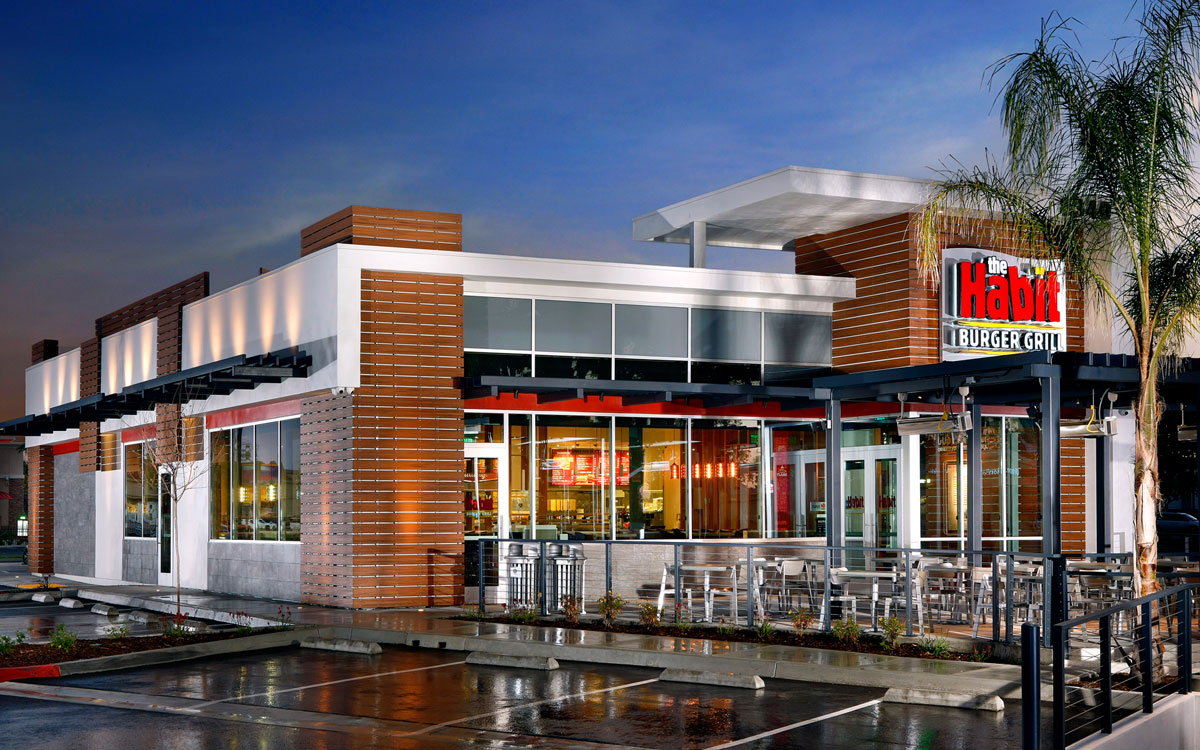Similar to other restaurants, The Habit Grill was forced to adapt amid the pandemic.
CEO Russell Bendel says the first priority was to keep employees and customers safe. The second priority was to keep stores open to serve the community and keep employees working.
He describes the company as a limited-service fast-casual brand. Habit operates under Yum! Brands (parent of Taco Bell, KFC, and Pizza Hut), which completed its $375 million acquisition of the burger chain in March.
Facilitating takeout isn’t a foreign concept, but 60 percent of revenue is traditionally from orders consumed on-premises.
Out of about 276 locations in 13 states, about 50 units have traditional drive-thrus, a service the company is moving toward. Bendel says 40 to 50 percent of new stores have a drive-thru, and the food is still cooked to order.
For the stores without a drive-thru, Habit quickly implemented three main options depending on location—no-contact pop-up drive thru, no-contact drive-up service, and no-contact curbside service.
“I think there’s been a shift in consumer behavior over the last couple of years,” Bendel says. “People certainly lean into convenience and utilizing digital channels to make your brand accessible to people. And they have certainly adapted and gotten much more comfortable, familiar, and are really looking for those all-access types of opportunities to be able to access your brand, order food, in a very safe and convenient manner. That certainly is the environment in which we’re operating today.”
Bendel says the company worked with landlords and developers to assess physical situations. At some locations, the chain used cones, tents, and signage to create a drive-thru lane. Employees take the order on a tablet, and the food is brought to the customer. Apple Pay and Google Pay are emphasized to avoid the exchange of credit cards.
The CEO refers to the pop-up drive-thru as the desirable option. However, if the unit doesn’t lend itself to that option, customers are asked to drive up to the building in identified parking spaces where their order will be taken.
“We have different scenarios that we can utilize based on the physical plant, the shopping center, company management,” Bendel says. “We looked at all the options that are available to us and really what we’re trying to do, especially during the time of the pandemic, is really limit the contact.”
For curbside service, Habit rolled out a feature that allows customers to order ahead whether it’s from the desktop, phone, app, or call center. When the food is ready, customers receive a text, and they can either pick up the order inside or identify the color and make of their car so an employee can bring the food to them.
The new tech is part of a strategy that began 18 months ago, Bendel says. Habit had online ordering, but the IT team formatted the website for mobile devices, formed call centers to handle phone orders, introduced kiosks at a number of locations, and developed a proprietary app with several features focused on ease of ordering. The app has been downloaded more than 300,000 times in the past few months, with about 2,300 downloads happening each day now.
“[The app] wasn’t all turned on, but over the last number of weeks, we have moved at warp speed to address the needs of customers, really which are more around safety than anything,” Bendel says.
To ensure the health and safety of customers and employees, Bendel says Habit sought the most stringent requirements across the country. All restaurants check employees’ temperatures with a digital thermometer when they arrive and every four hours during shifts. All employees are using masks and gloves, and there are sanitation stations inside.
The chain is making an impact outside its doors, as well. In California, where the Habit has a significant presence, the chain converted 10 catering trucks to feed healthcare professionals and first responders in the last three weeks, providing more than 20,000 meals.
Bendel believes when the pandemic is over, customers’ habits won’t change quickly. Early on, the CEO says social distancing will not only be a regulatory requirement, but it will be a rule demanded by customers.
“So we’re looking at how do we adjust dining rooms and queue lines for that scenario,” Bendel explains. “I think all of the digital enhancements and adjustments we’re making to become more convenient will resonate strongly with consumers. I think the curbside option is something we’ll probably continue forever because it certainly addresses the needs of the customers on a number of fronts. I think there’s a whole new way of looking at things. Gloves and masks will certainly be with us short and mid-term. We’re going to look at all of those options.”
Habit has exposed kitchens where customers can watch production. Customers will lean into brands that can form that type of trust, the CEO says.
As the pandemic continues, Bendel says the chain will continue seeking best practices so customers will look to his restaurant as having those high standards.
“That isn’t something that’s new for us,” Bendel says. “We’ve been in business for over 50 years. Very humbly speaking, our success has always been around the direct relationship we have not only with serving great food at a fair price, but people have always looked at us and viewed it as a very safe environment.”







